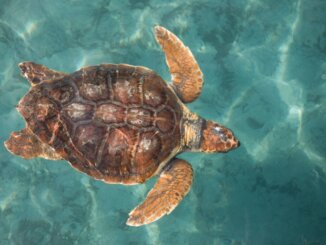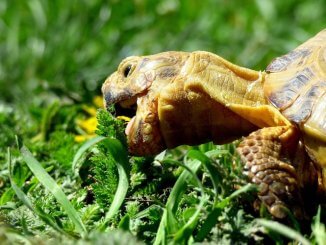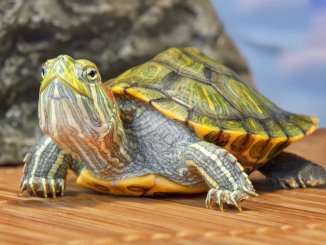Did you know that the Golden Greek Tortoise isn’t a proper species name?
Collectors and pet owners refer to any golden or yellow-colored tortoise belonging to the family Testudo Graeca Terrestris as a Golden Greek Tortoise.
Their striking golden color, small size, and easy temperament make them ideal animals for anyone interested in herpetoculture.
So it’s no surprise that Golden Greek tortoises top our list of the best pet tortoise breeds for beginners.
Golden Greek Tortoise Overview
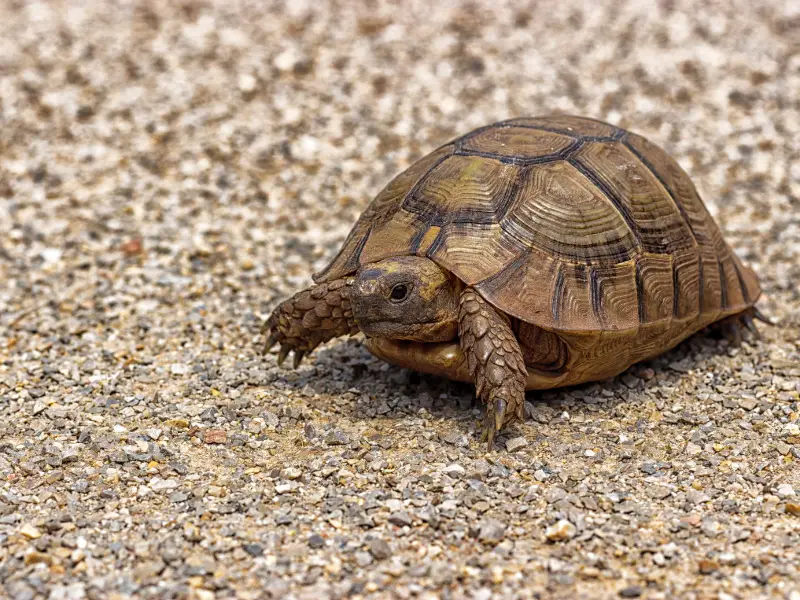
| Common name | Golden Greek tortoise, spur-thighed tortoise |
| Scientific name | Testudo graeca terrestris |
| Natural habitat | Moderate to hot arid climates |
| Adult size | 5 - 7 inches |
| Average lifespan | 100 years |
| Diet | Shrubs, Weeds, Alfalfa (plants), Cactus pad/leaf, Collard greens, and Dandelion greens |
| Housing | 5’ x 5’ outdoor pens, or a 3’ x 6’ indoor housing |
| Experience | Beginner |
Origin
Despite its name, the Golden Greek Tortoise (Testudo Graeca Terrestris) does not originate from Greece.
Instead, it comes from various places, like North Africa, southwest Asia, and southern Europe.
These tortoises inhabit a wide range of habitats, from rocky hillsides to Mediterranean scrub, forests, and even fields and meadows.
Appearance And Behavior
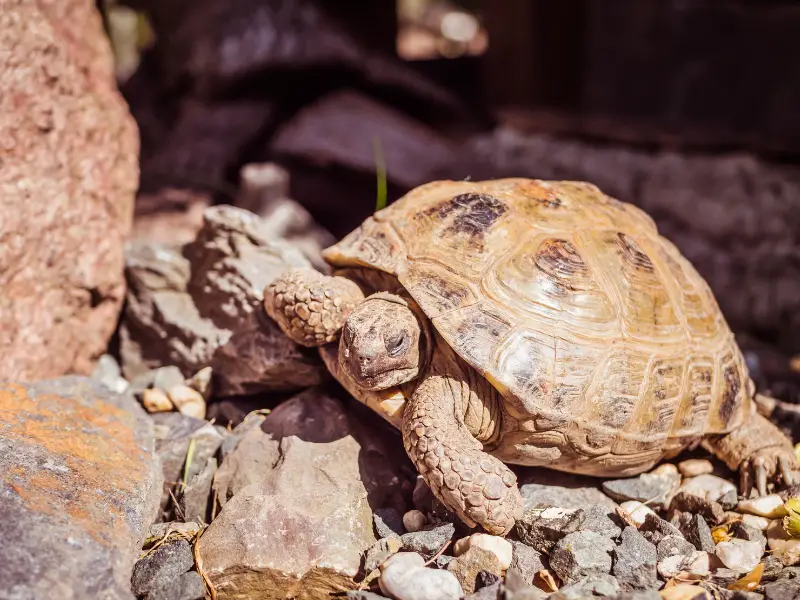
Golden Greeks come in shades from yellow-gold to black or dark brown. Owners can often find borders, rays, specks, and spots on the shell.
These patterns look like a Greek mosaic. It’s this appearance that gives them the name ‘Greek Tortoise’. On either side of the tail, there are one to three raised scales, spurs, or tubercles.
The Golden Greek has a blunt head with large, expressive eyes. Its front legs have large scales and powerful, thick claws.
Like most tortoises, the Golden Greek is an easy-going, friendly tortoise. However, owners should minimize handling them to avoid stressing them out.
Size And Lifespan
A male adult Golden Greek tortoise can grow to 5″, while females are slightly larger, growing up to 7″.
Since they are reproductively compatible with various other Greek tortoise subspecies, some owners report Golden Greeks, with an unknown origin, growing up to 11″.
Like most tortoises, the Golden Greek has a long lifespan.
In the wild, they rarely live longer than 20 years. However, if caretakers look after them in captivity, they can live past 100 years. They’re often known for outliving their handlers.
Temperament
Golden Greeks are friendly, interactive tortoises. They love exploring, and some of them can even climb.
As docile animals, it’s relatively easy to interact with them. To avoid fighting, it’s best to house one male with several females.
If there is more than one male in an enclosure with females, they’ll constantly battle for dominance.
Pet owners and collectors should take care to avoid buying freshly imported Golden Greeks.
Fresh imports can be unpredictable and temperamental. Only experienced handlers should work with new imports.
In contrast, captive-bred Golden Greek tortoises are fantastic for beginners. Their easy temperament makes them incredible, easy-going pets to raise.
Housing The Golden Greek Tortoise
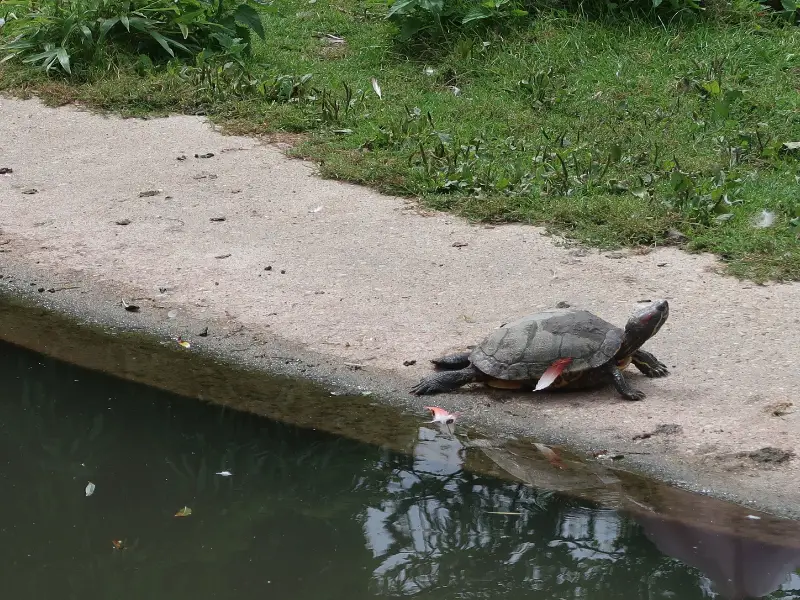
Collectors have several excellent options to house this tortoise species. Your best choice depends on the climate where you’ll house your tortoise.
If you live in a cold, moist area, it’s best to keep them indoors. However, if you live in a sunny, warm place, your Golden Greek can thrive outside.
Enclosure Size
Outdoors
Collectors and pet owners should always try to house their Golden Greek outside if possible. To house a tortoise outside, you must construct a naturalistic pen.
The pen should have lots of edible vegetation and receive a lot of natural sunlight. Aim for a nice balance of shade and sun throughout the enclosure.
The larger the pen is, the better your Golden Greek will adapt. Make sure you bury the pen walls at least 6 inches deep.
Burying the walls prevents the tortoise from digging under them and escaping. If your Golden Greek tortoise is younger than 24 months, it’s best to keep them indoors.
Baby tortoises dehydrate quickly and need extra care.
Indoors
If collectors plan on keeping a Golden Greek tortoise indoors, it’s best to construct a “tortoise table” from plywood. The enclosure should be at least 3′ x 6′. Avoid using plastic or glass.
These materials can easily confuse the tortoise and they may constantly bump their heads against it. The tortoise shouldn’t be able to see through the enclosure. If they can, it’ll only stress them out.
Lighting
Only baby Golden Greek tortoises, and those kept indoors, will require special lighting as outdoor tortoises will see natural sunlight.
If you’re keeping your tortoise indoors, provide them with UVB lighting throughout the day. Indoor tortoises will also need a basking light.
Set this light up on one side of the enclosure so that your tortoise can self-regulate their temperature.
Temperature And Humidity
Golden Greek tortoises are hardy creatures and relatively temperature tolerant. However, when the temperature drops this low, it’s important to know that your tortoise won’t eat as much as it usually does.
Golden Greeks thrive in daytime temperatures between 75 and 85°F. At night, the temperature may drop as low as 65°F. All Golden Greeks require a basking spot that should be at least 90 to 100°F.
Indoor tortoises will need an enclosure with a temperature gradient. This gradient should be around 75°F at the cool end and warm up to 100°F under the basking light.
Humidity levels should be below 50% as these tortoises come from dry climates. High humidity can cause respiratory problems. However, babies will require higher humidity.
If you plan on keeping babies and juveniles indoors, make sure that the enclosure has a warm, slightly damp substrate. The young tortoises will burrow into the substrate to aid in humidity, which will help with smooth shell growth.
Substrate And Decoration
Avoid substrates like gravel or sand. Golden Greeks may ingest these substrates, causing severe health issues. The best substrate for Golden Greek adults is orchid bark, plain soil, fine coconut coir, coconut husk chips, and even cypress mulch.
For best results, mix these substrates in the pen. Young juveniles or babies love to dig into soft, warm, slightly damp substrates.
Consider providing them with sphagnum moss, coconut fiber, or even soil. Mix these substrates together for an even better experience to create the perfect environment for young tortoises.
The Golden Greek tortoise tends to prefer burrows over hides. Create an enclosure using different substrates, some dry and others slightly wet.
This allows the tortoise to choose the environment they like. Always avoid waterlogged substrates. If a Golden Greek can’t dry off, it may develop shell rot.
Typically, slightly damp areas are best. Feel free to add a variety of decorations to the enclosure. Rocks, branches, and plants will create a fun-filled, exciting enclosure.
Cleaning
A Golden Greek tortoise’s enclosure requires minimal maintenance. Owners should remove any droppings as soon as possible.
They can also disinfect the enclosure with a mixture of 1 tablespoon bleach added to a cup of water. Only disinfect the enclosure once a month. Remember to rinse the pen and decorations after disinfection.
Always wash and disinfect water bowls. Let the enclosure and bowls air out for an hour before returning the tortoise to its enclosure.
You can keep the Golden Greek in a deep storage tub during the cleaning process. A deep tub will prevent them from climbing out and escaping.
Golden Greek Tortoise Care
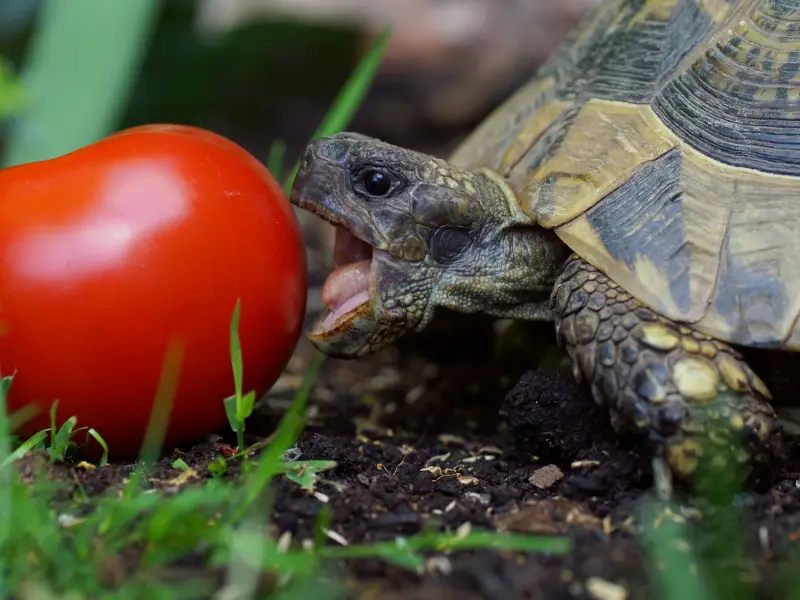
Golden Greeks are hardy animals, and while there is no “best way” to look after them, there are several great ways to ensure they live a long happy life.
How owners look after the Golden Greek will mainly depend on their specific circumstances, such as climate, seasons, and the housing setup.
Food And Water
All Golden Greek tortoises are herbivores. They require a diet rich in fiber and low in protein. Providing them with various leafy, calcium-rich greens and other vegetables is best.
Owners can feed their tortoises a variety of:
- fresh romaine, collard greens, mustard greens
- lettuce, squash, zucchini
- bell peppers, shredded carrots
- weeds like cat’s ear, wild strawberry, thistle, clover, and dandelion
The more varied the diet, the better your Golden Greek’s health will be. During the winter, it’s vital to supplement their diet with a tortoise-specific multivitamin that contains vitamin D3.
This vitamin helps tortoises build strong bones, absorb calcium, and maintain phosphorus levels. The Golden Greek also requires fresh drinking water. A shallow dish should be enough for adults.
They will dip their heads in to drink as and when they need to. It’s also a good idea to ensure that their leafy greens are damp to help your tortoises stay hydrated.
Soak adults once or twice a month in a washing bowl to help with hydration. Often, a 10 to 60-minute soak in warm, shallow water is ample.
Hatchlings will require more water. Owners should bathe them daily to ensure they get enough water.
Handling
Like most reptiles, Golden Greek tortoises don’t like to be handled by humans. When people handle them, it can cause them a lot of stress, which can lead to poor health and anxiety.
Golden Greeks may even bite when roughly picked up. So, when owners must handle their Golden Greek, including when moving it out of the enclosure for cleaning, they should do it slowly and gently.
As long as their needs are met and they aren’t unnecessarily handled, the Golden Greek tortoise is an amicable and gentle creature. They’re even known for becoming pretty social and will run up to their owners if they have food in their hands.
Common Health Issues
It’s always best to buy a captive, local Golden Greek over imports. If an owner purchases an import, they should immediately take them to a registered veterinarian.
The vet can perform several exams, such as fecal and blood tests, to determine the tortoise’s health. Wild Golden Greeks may carry parasites or worms and should be dewormed if this is the case.
Without adequate care, they may suffer and die. Local, captive-bred Golden Greeks tend to be hardier.
Their hardiness may vary since they may originate from different areas with different climates. For instance, some Golden Greeks don’t tolerate high humidity or cold temperatures.
Others, in contrast, do better in cold temperatures, as long as it’s dry.
Shell rot is a common issue when a tortoise stays in a wet enclosure. If you suspect your pet is developing shell rot, you must take it to a vet as soon as possible.
As long as owners provide the Golden Greek with optimal living conditions, they’ll be hardy little tortoises that can easily outlive their caretakers.
Aestivating Or Brumation
Golden Greek tortoises are ectothermic. This means they are cold-blooded and don’t hibernate. Instead, they enter a state of dormancy during cold or unfavorable weather conditions.
This condition is known as brumation or aestivation. The tortoise will be less active, and may not eat as much during this time.
Breeding
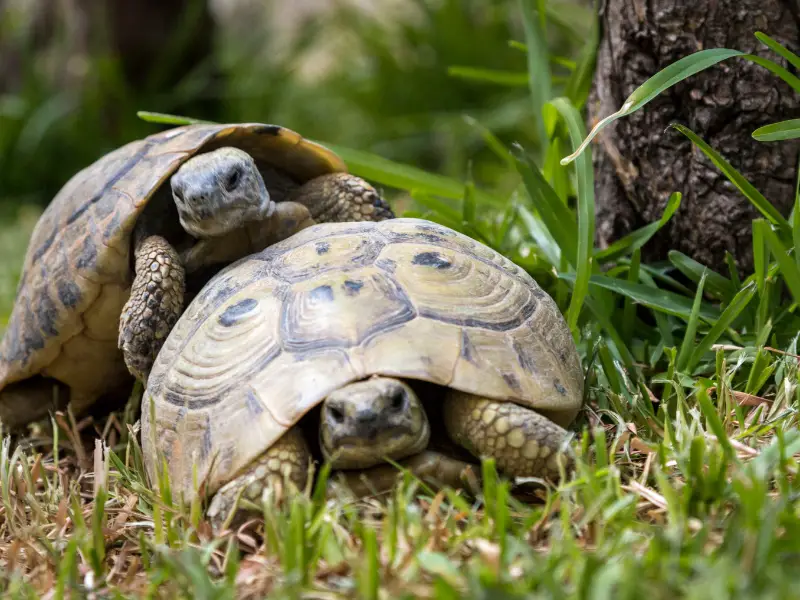
Collectors that want to breed their Golden Greeks will first have to identify the sex of each tortoise in their collection. Determining the sex, called sexing, is relatively easy once they reach around 4 inches in length.
Identifying The Males
Male Golden Greeks have long tails. The vent openings end outside the edge of the shell when they extend their tales. Males tend to walk with their tails tucked up sideways under the shell. Once the male is around 4 or 5 inches in length, they should be fertile.
Identifying The Females
Females tend to be larger than males. They also retain their short, wide, button-like tails. The females will walk around with the tail pointed straight out unless harassed or stressed.
Females should be ready to mate around the time that they reach 5 to 6 inches in length.
Settling In The Females
Like most tortoises, the females in a collection will require some time to settle in. They need this time to adjust to their new surroundings before they’re ready to start breeding and laying eggs.
Golden Greek females require at least a year to settle in. During this time, they’ll create hierarchies in which the dominant female will emerge.
To ensure a successful breeding season, collectors should set up their female groups as soon as possible. Don’t introduce new females during the year; let them establish their social hierarchy first.
Adding The Males
During spring, add two males into the female group. For the best success, stick to a ratio of two males with six females.
Leave the males with the females for a week. After a week, remove the males. This gives the females some much-needed rest.
After the week’s rest, add two new males into the group. Continue this cycle until early summer or until the Golden Greeks lay their first clutch of eggs.
Nesting
Golden Greeks will dig shallow nests in hard soil. Should the ground be soft, they’ll dig deep nests. Owners should dig up the nests once a week, starting from March to the end of April.
The Golden Greek females can lay 2 to 6 eggs per clutch. During this period, they may lay up to 4 clutches. Once owners have collected all the eggs from the nests, they should put them into an incubator.
Incubation
Owners can influence the gender of the hatchlings during incubation. Generally, Golden Greek eggs must be incubated at 86°F. However, for more males, drop the temperature to 82°F. In contrast, for more females, raise the temperature to 92°F.
The Golden Greek eggs will gradually change from smooth gray to bright white. This change should happen within the first few days. Depending on the incubation temperature, the eggs will hatch after 65 to 75 days.
Choosing And Buying A Golden Greek Tortoise
The Golden Greek tortoise is a fascinating, beautiful tortoise. Since they are such hardy and friendly animals, they’re a perfect choice for inexperienced pet owners and collectors. However, there are a few things to keep in mind when buying a Golden Greek tortoise.
- Opt for reputable breeders: Reputable breeders will know the tortoise’s medical history. Since you’re committing to a pet with a very long lifespan, it’s always best to start with a healthy tortoise.
- Recognize the signs of a healthy tortoise: A healthy Golden Greek has clear eyes and a smooth shell without deformity, rot, or decay. They also have no excess mucus around the nose and mouth.
- Watch it eat: Ask the breeder if you may watch the tortoise eat. The only Golden Greek that refuses to eat is an ill one.
- Secure a vet: It’s always wise to know whether there’s a registered vet capable of dealing with exotic animals in the area. A vet close to you makes it easier to ensure that your Golden Greek has the best possible care on hand.
- Do research: Always do research, read care guides like this one, and learn how to look after your Golden Greek tortoise.
On average, Golden Greeks are available for $200 each. They’re readily available from online stores, importers, and local breeders.
This long-living animal will provide first-time and experienced pet owners and collectors with years of joy and pleasure.

